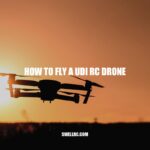FAA Drone Tracking: What You Need to Know
Drones are becoming increasingly popular for recreational and commercial use, but as the number of drones in the skies continues to rise, so do concerns about safety and security. The Federal Aviation Administration (FAA) is responsible for regulating airspace and ensuring that drones are operated safely and responsibly. One common question among drone owners is whether the FAA can track their drones. The short answer is yes, but there are certain factors that affect how and when the FAA can track a drone. It’s important for drone owners to understand how the FAA tracks drones and what regulations apply to the operation of drones to ensure that they are operating within the law and contributing to a safe airspace for all. In this article, we’ll explore how the FAA can track your drone, the legal and privacy implications of drone tracking, and what you can do to ensure that you are following all FAA regulations and guidelines for safe drone operation.
How can the FAA track your drone?
The FAA can track your drone through various means such as:
- Registration: All drones must be registered with the FAA, and the registration number must be displayed on the outside of the aircraft. This allows the FAA to identify the drone and track down any violations.
- Radar: The FAA uses radar systems to detect drones that are in the airspace. This is an effective way for the FAA to monitor the skies and identify potential safety hazards.
- UAS Traffic Management (UTM) system: The UTM is a digital system that manages airspace for drones. It allows the FAA to track and manage the flow of drone traffic in real-time, reducing the risk of collisions and other safety hazards.
It’s important to note that the FAA’s ability to track your drone depends on a few factors, including the type of drone you own, the airspace you’re flying in, and whether you’re flying for recreational or commercial purposes. If you’re unsure about the rules and regulations that apply to your drone, the FAA website is a great resource for information. Additionally, there are several third-party websites and apps that can help you stay up-to-date on the latest FAA regulations and track your drone in real-time.
Can the FAA track my drone?
Yes, the Federal Aviation Administration (FAA) can track your drone’s location. The FAA requires all drones weighing over 0.55 pounds to be registered with them, which includes providing the drone’s serial number and owner’s contact information. This registration allows the FAA to track a drone’s location in case of any issues.
Additionally, some new drones come equipped with GPS technology that can be tracked by the FAA or other regulatory authorities.
It’s important to follow all FAA regulations and guidelines when flying your drone to ensure everyone’s safety and avoid any potential legal issues.
For more information about drone regulations and registration, visit the FAA’s website at https://www.faa.gov/uas/.
Legal Implications of Breaking FAA Regulations
If you are caught breaking FAA regulations, you could face the following consequences:
| Violation | Possible Penalty |
|---|---|
| Flying in restricted airspace or over people without the proper waivers or exemptions | Up to $20,000 in fines and the possibility of criminal charges |
| Operating a drone under the influence of drugs or alcohol | Up to $25,000 in fines and the possibility of criminal charges |
| Not registering your drone or displaying your registration number | Up to $27,500 in fines |
| Flying commercially without an FAA Remote Pilot Certificate | Up to $1,414 per violation |
It’s important to follow all FAA regulations and guidelines to avoid fines and legal trouble. The FAA takes safety seriously and enforces these regulations to ensure that everyone in the airspace is protected. If you’re unsure about the rules and regulations that apply to your drone, you can visit the FAA website or consult with a professional drone operator. Additionally, there are several third-party websites and apps that can help you stay up-to-date on the latest FAA regulations and avoid potential legal trouble.
What happens if you get an FAA violation?
If you get an FAA (Federal Aviation Administration) violation, you could face consequences such as fines, license revocation or suspension, mandatory training, or even criminal charges. Here are some things to keep in mind:
- FAA violations include breaking airspace restrictions, flying without proper certification or authorization, and operating an aircraft in a careless or reckless manner.
- FAA penalties can range from as little as a warning letter to thousands of dollars in fines.
- Depending on the severity of the violation, you may also have to attend remedial training, undergo reexamination, or have your pilot’s license suspended or revoked.
If you receive a notice of violation from the FAA, it’s essential to take it seriously and seek legal counsel if necessary. For more information regarding FAA violations, you can refer to their official website.
Privacy Concerns with FAA Drone Tracking
While the FAA primarily uses drone tracking for safety and compliance purposes, there are some privacy concerns to consider. Some people worry that the FAA’s ability to track drones could lead to surveillance or the misuse of personal information. Here are some points to consider:
- The FAA has access to drone owners’ personal information, including their name and address.
- If you use a drone for commercial purposes, your business name and contact information may also be public record.
- While the information the FAA collects is primarily used for regulatory and safety purposes, it could potentially be used for other purposes in the future.
- If you’re concerned about privacy, you may want to consider using a drone communication system that encrypts your drone’s signal and protects your information from interception.
Overall, while the FAA’s drone tracking capabilities may raise privacy concerns, the benefits of increased safety in the airspace generally outweigh these concerns. It’s up to drone operators to follow all FAA regulations and guidelines and take steps to protect their privacy when necessary.
Can the FAA track your drone?
The FAA can track some drones, but they cannot track all drones. The FAA requires all drones that weigh more than 0.55 pounds to be registered. The registration process includes providing your name, physical address, and email address. This information links the drone to the owner, making it possible for the FAA to track a registered drone if needed. However, if a drone is not registered or if the registration is not up to date, the FAA will not be able to track it.
It is important to follow all FAA regulations when flying a drone to avoid any legal issues. For more information on drone regulations and registration requirements, visit the FAA’s website.
Ways to Mitigate Risk with FAA Drone Tracking
If you’re concerned about the FAA tracking your drone or want to minimize the risk of being caught violating regulations, there are several things you can do:
- Familiarize yourself with all FAA regulations and guidelines and follow them closely.
- Avoid flying your drone in restricted airspace or other areas where flying is prohibited.
- Register your drone and display your registration number on the outside of the aircraft.
- Consider using an encrypted drone communication system to prevent interception by others.
- Always be aware of your surroundings and other aircraft in the airspace to avoid collisions.
- Invest in a drone with built-in safety features, like obstacle avoidance and geofencing technology.
By following these guidelines and taking steps to protect your privacy, you can fly your drone safely and responsibly while minimizing your risk of being caught violating FAA regulations.
Can FAA track your drone?
Yes, the Federal Aviation Administration (FAA) can track your drone. If you fly drones for recreational purposes, you need to register your drone with the FAA. Registered drones provide the FAA with a unique identification number which helps them track the drone’s activity. In addition to registration, the FAA has also implemented the Remote ID rule that requires drone manufacturers to develop technology that allows tracking and identification of drones. This rule is expected to become effective on September 16, 2023.
For more information, visit the FAA’s website: https://www.faa.gov/uas/getting_started/register_drone/ or https://www.faa.gov/uas/research_development/remote_id/
Conclusion
In summary, the FAA has the ability to track drones using a variety of methods and tools. While this may raise privacy concerns for some, it is primarily for safety and compliance purposes. By following all FAA regulations and guidelines, avoiding restricted airspace, using encrypted communication systems, and investing in drones with safety features, you can fly your drone safely and responsibly while minimizing your risk of being caught violating regulations. Remember that the FAA’s primary focus is on safety, so it’s important to prioritize that as well when flying your drone. By doing so, you can enjoy the benefits of drone technology without the risk of legal consequences.


